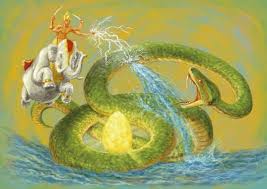 In the Rigveda Vritra was a monster whose name meant the one who “held back,” “restrained,” or “enveloped.” Killing Vritra was Indra’s crowning moment. Vritra enveloped a celestial mountain and held back its waters, but Indra’s action released the waters, bring the fertilizing rains and prosperity to the Aryans, even providing soma for gods and men. He did this with his thunderbolt, implying that he was a nature god of rain and storm, but also a war god who brought victory and bounty. He accomplished his victory over Vritra by both his strength as a warrior and his magic as a priest. Since Vritra also used magic in the single combat against Indra, he was later said to be a brahmin—thus in the later versions making Indra a brahmin-killer. Also later, it was a brahmin who provided his own thigh bone to make the divine weapon, Indra’s thunderbolt (vajra)—the sage Dadhici. Alternately, Indra was reduced in the Puranic literature to so little of his former power that he had to be joined by other gods to conquer Vritra, or even to receive his ability to conquer Vritra from (Siva or Vishnu.
In the Rigveda Vritra was a monster whose name meant the one who “held back,” “restrained,” or “enveloped.” Killing Vritra was Indra’s crowning moment. Vritra enveloped a celestial mountain and held back its waters, but Indra’s action released the waters, bring the fertilizing rains and prosperity to the Aryans, even providing soma for gods and men. He did this with his thunderbolt, implying that he was a nature god of rain and storm, but also a war god who brought victory and bounty. He accomplished his victory over Vritra by both his strength as a warrior and his magic as a priest. Since Vritra also used magic in the single combat against Indra, he was later said to be a brahmin—thus in the later versions making Indra a brahmin-killer. Also later, it was a brahmin who provided his own thigh bone to make the divine weapon, Indra’s thunderbolt (vajra)—the sage Dadhici. Alternately, Indra was reduced in the Puranic literature to so little of his former power that he had to be joined by other gods to conquer Vritra, or even to receive his ability to conquer Vritra from (Siva or Vishnu.
There was a rebirth story in the later Puranas that explained Vritra’s origin. He came from a curse by Parvati. Citraketu had received a boon that allowed him to fly with his wife. He both misused it and laughed at Siva‘s wife, Parvati. She and (Siva were playing in Kailasa and Citraketu thought their love play was humorous. However, Parvati did not think much of being spied upon and cursed Citraketu to be reborn as Vritra-asura.
The killing of Vritra and his cohorts is one of the many places where Vedic myths can be compared with Indo-European mythology. This theme—the killing of the dragon—has many versions. It involves a particularly ancient myth of creation by dismemberment, fertility motifs that require sacrifice, and the sin or pollution of these acts, which can only be purified by the rituals known by the wise of the community.
